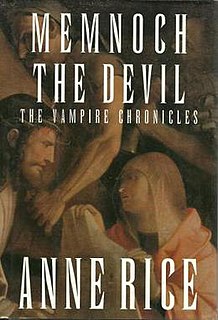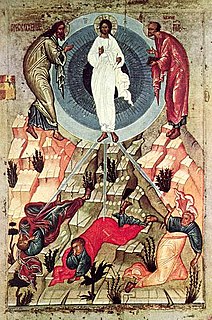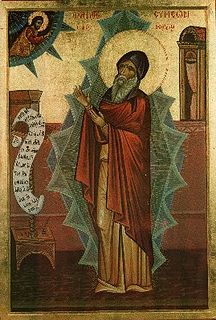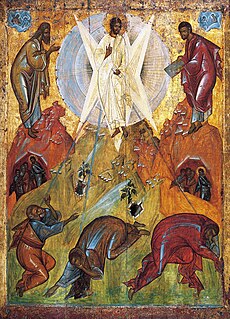Related Research Articles

Anthony the Great, was a Christian monk from Egypt, revered since his death as a saint. He is distinguished from other saints named Anthony, such as Anthony of Padua, by various epithets: Saint Anthony, Anthony of Egypt, Anthony the Abbot, Anthony of the Desert, Anthony the Anchorite, Anthony the Hermit, and Anthony of Thebes. For his importance among the Desert Fathers and to all later Christian monasticism, he is also known as the Father of All Monks. His feast day is celebrated on 17 January among the Orthodox and Catholic churches and on Tobi 22 in the Coptic calendar.

Chastity, also known as purity, is a virtue related to temperance. Someone who is chaste refrains either from sexual activity considered immoral or any sexual activity, according to their state of life. In some contexts, for example when making a vow of chastity, chastity means the same as celibacy.

Memnoch the Devil (1995) is a horror novel by American writer Anne Rice, the fifth in her Vampire Chronicles series, following The Tale of the Body Thief. In this story, Lestat is approached by the Devil and offered a job at his side.

Christian mysticism refers to mystical practices and theory within Christianity. Mysticism is not so much a doctrine as a method of thought. It has often been connected to mystical theology, especially in the Catholic Church and Eastern Orthodoxy and Oriental Orthodoxy.

The Desert Fathers or Desert Monks were early Christian hermits and ascetics, who lived primarily in the Scetes desert of the Roman province of Egypt, beginning around the third century AD. The Apophthegmata Patrum is a collection of the wisdom of some of the early desert monks and nuns, in print as Sayings of the Desert Fathers. The first Desert Father was Paul of Thebes, and the most well known was Anthony the Great, who moved to the desert in AD 270–271 and became known as both the father and founder of desert monasticism. By the time Anthony had died in AD 356, thousands of monks and nuns had been drawn to living in the desert following Anthony's example, leading his biographer, Athanasius of Alexandria, to write that "the desert had become a city." The Desert Fathers had a major influence on the development of Christianity.

Symeon the New Theologian was an Eastern Orthodox Christian monk and poet who was the last of three saints canonized by the Eastern Orthodox Church and given the title of "Theologian". "Theologian" was not applied to Symeon in the modern academic sense of theological study; the title was designed only to recognize someone who spoke from personal experience of the vision of God. One of his principal teachings was that humans could and should experience theoria.
The phrase baptism by fire or baptism of fire is a phrase originating from the words of John the Baptist in Matthew 3:11.
Matthew 3:11 "I indeed baptize you with water unto repentance: but he that cometh after me is mightier than I, whose shoes I am not worthy to bear: he shall baptize you with the Holy Ghost, and with fire" King James Version 1611
The image of God is a concept and theological doctrine in Christianity, as well as in Judaism. This concept is a foundational aspect of Christian and Jewish understandings of human nature. It stems from the primary text in Genesis 1:27, which reads: "So God created man in his own image, in the image of God created he him; male and female created he them." The exact meaning of the phrase has been debated for millennia.

Matthew 6:22 is the twenty-second verse of the sixth chapter of the Gospel of Matthew in the New Testament, and is part of the Sermon on the Mount.

Adam is the name given in Genesis 1-5 to the first human. Beyond its use as the name of the first man, adam is also used in the Bible as a pronoun, individually as "a human" and in a collective sense as "mankind". Genesis 1 tells of God's creation of the world and its creatures, including adam, meaning humankind; in Genesis 2 God forms "Adam", this time meaning a single male human, out of "the dust of the ground", places him in the Garden of Eden, and forms a woman, Eve, as his helpmate; in Genesis 3 Adam and Eve eat the fruit of the tree of knowledge and God condemns Adam to labour on the earth for his food and to return to it on his death; Genesis 4 deals with the birth of Adam's sons, and Genesis 5 lists his descendants from Seth to Noah.

Edifying Discourses in Diverse Spirits or Upbuilding Discourses in Various Spirits are English translations for the title of a work published on March 13, 1847, by Søren Kierkegaard. The book is divided into three parts just as Either/Or was in 1843 and many of his other discourses were. Kierkegaard had been working toward creating a place for the concepts of guilt and sin in the conscience of the single individual. He discussed the ideas generated by both Johann von Goethe and Friedrich Hegel concerning reason and nature. This book is his response to the ideas that nature and reason are perfect.
The New Church is any of several historically related Christian denominations that developed as a new religious group, influenced by the writings of scientist and mystic Emanuel Swedenborg (1688–1772).
Union Espiritista Cristiana de Filipinas, Incorporada is a religious Association with more than a thousand affiliated local and foreign based centers (churches), and considered as the biggest Association of christian spiritists in the Philippines. Foreign based centers are located in California, Canada, Hong Kong, Macau, Taiwan, Singapore, Greece, Dubai, Abu Dhabi, Hawaii, Germany, Italy, and Russia, where there are large Filipino communities. Union members are called "Christian Spiritists" and are affiliated with the International Spiritualist Federation.
Saint Karas the Anchorite, also known as Anbba Karas, was a saint of the Coptic Orthodox Church who lived during the late fifth and early sixth centuries. Anbba Karas used to be a monk. According to his biographer, the Coptic monk Saint Pambo, he spent 57 years in isolation in the Scetis Desert in communion with God who visited him every day in his cave. After his death,God closed the cave on his body as the world doesn't deserve his footstep. The location of his cave is unknown.

The theology on the body is a broad term for Catholic teachings on the human body.

In various theistic religious traditions an angel is a supernatural spiritual being who serves God.

"Thou shalt not covet" is the most common translation of one of the Ten Commandments or Decalogue, which are widely understood as moral imperatives by legal scholars, Jewish scholars, Catholic scholars, and Protestant scholars. The Book of Exodus and the Book of Deuteronomy both describe the Ten Commandments as having been spoken by God, inscribed on two stone tablets by the finger of God, and, after Moses broke the original tablets, rewritten by God on replacements.

Christian contemplation, from contemplatio, refers to several Christian practices which aim at "looking at", "gazing at", "being aware of" God or the Divine. It includes several practices and theological concepts, and until the sixth century the practice of what is now called mysticism was referred to by the term contemplatio, c.q. theoria.

In Christianity, heaven is traditionally the location of the throne of God and the angels of God, and in most forms of Christianity it is the abode of the righteous dead in the afterlife. In some Christian denominations it is understood as a temporary stage before the resurrection of the dead and the saints' return to the New Earth.
AbbaOr of Nitria was an Egyptian Orthodox Christian ascetic who lived around the 4th century AD in Egypt in Dalga, Nitria, the Thebaid, and in the deserts around Shaina. He is one of the lesser-known Desert Fathers, but is nevertheless regarded as one of the "chief among monks," being, "a man who stood out among many of the fathers." He is associated with Theodore and Sisoes the Great. According to Jerome, at one point during his life, Or was the father of "one thousand [cenobitic] monks" in the Egyptian Desert. Or died c. 390.